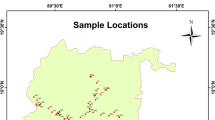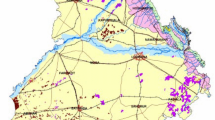Abstract
Groundwater used for domestic purpose without proper treatment should be free from chemical and biological contaminants. This study was carried out to assess the groundwater quality with respect to uranium in a part of Nalgonda district, Andhra Pradesh, India. Groundwater was regularly monitored for uranium concentration by collection of samples once every two months from March 2008 to November 2009 from 44 wells. The concentration of uranium in groundwater ranged from 0.2 to 118.4 ppb. Groundwater is unsuitable for domestic use in 2 % of this area based on the limit of 60 ppb prescribed by the Atomic Energy Regulatory Board of India. However, due the wide variation in limit suggested by different organizations and countries, the no-observed-adverse-effect level and lowest-observed-adverse-effect level (in mg/kg day) was used to understand the dosage of uranium that reaches the people through drinking water pathway. This level varied from 0 to 0.02 mg/kg day and 0 to 0.08 mg/kg day based on an uncertainty factor of 10 and 50 respectively for the mean uranium concentration in groundwater in each well. With an uncertainty factor of 50, 5 groundwater samples had uranium above 0.06 mg/kg day which is the lowest-observed-adverse-effect level. This study showed that with the presence of present level of uranium concentration in groundwater of this area there is no major threat to humans through the drinking water pathway.












Similar content being viewed by others
References
Korfali SI, Jurdi M (2007) Assessment of domestic water quality: case study, Beirut, Lebanon. Environ Monit Assess 135:241–251
Dawoud MA, Raouf ARA (2009) Groundwater exploration and assessment in rural communities of Yobe State, Northern Nigeria. Water Resour Manag 23(3):581–601
Toshisuke M, Fumikazu N, Hiroshi T, Kimihito N, Takeo O (2011) Assessment of the long-term variation in the nitrogen pollution load potential from farmland to groundwater in the Tedori River Basin, Japan. Paddy Water Environ 9:441–449
Nosrati K, Eeckhaut MVD (2012) Assessment of groundwater quality using multivariate statistical techniques in Hashtgerd Plain, Iran. Environ Earth Sci 65:331–344
Brindha K, Elango L (2011) Hydrochemical characteristics of groundwater for domestic and irrigation purposes in Madhuranthakam, Tamil Nadu, India. Earth Sci Res J 15(2):101–108
Liu CW, Jang CS, Chen CP, Lin CN, Lou KL (2008) Characterization of groundwater quality in Kinmen Island using multivariate analysis and geochemical modelling. Hydrol Process 22:376–383
Zhu C, Schwartz W (2011) Hydrogeochemical processes and controls on water quality and water management. Elements 7(3):169–174
Rajesh R, Brindha K, Murugan R, Elango L (2012) Influence of hydrogeochemical processes on temporal changes in groundwater quality in a part of Nalgonda district, Andhra Pradesh, India. Environ Earth Sci 65:1203–1213
Sinha RM, Shrivastava VK, Sarma GVG, Parthasarathy TN (1995) Geological favourability for unconformity-related Uranium deposits in northern parts of the Cuddapah Basin: evidences from Lambapur Uranium occurrences, Andhra Pradesh, India. Explor Res Atomic Miner 8:111–126
Simsek C (2008) Assessment of natural radioactivity in aquifer medium bearing uranium ores in Koprubasi, Turkey. Environ Geol 55:1637–1646
Chkir N, Guendouz A, Zouari K, Ammar FH, Moulla AS (2009) Uranium isotopes in groundwater from the continental intercalaire aquifer in Algerian Tunisian Sahara (Northern Africa). J Environ Radioact 100:649–656
Rana BK, Tripathi RM, Sahoo SK, Sethy NK, Sribastav VS, Shykla AK, Puranik VD (2010) Assessment of natural uranium and 226 Ra concentration in ground water around the uranium mine at Narwapahar, Jharkhand, India and its radiological significance. J Radioanal Nucl Chem 285:711–717
Shrivastava VK, Parthasarathy TN, Sinha KK (1992) Geochemical study of uraniferous granites from Lambapur area Nalgonda District Andhra Pradesh, India. Explor Res Atomic Miner 5:41–52
Singh RV, Sinha RM, Bisht BS, Banerjee DC (2002) Hydrogeochemical exploration for unconformity-related uranium mineralization: example from Palnadu sub-basin Cuddapah Basin, Andhra Pradesh, India. J Geochem Explor 76:71–92
Brindha K, Elango L (2011) Spatial assessment of groundwater quality based on minor ions. American Geophysical Union 2011 Fall Meeting, San Francisco, 5–9 December 2011
Brindha K, Rajesh R, Murugan R, Elango L (2011) Fluoride contamination in groundwater in parts of Nalgonda district, Andhra Pradesh, India. Environ Monit Assess 172:481–492
Brindha K, Rajesh R, Murugan R, Elango L (2010) Natural and anthropogenic influence on the fluoride and nitrate concentration of groundwater in parts of Nalgonda district, Andhra Pradesh, India. J Appl Geochem 12(2):231–241
Brindha K, Elango L (2010) Study on bromide in groundwater in parts of Nalgonda district, Andhra Pradesh. Earth Sci India 3(1):73–80
Elango L, Brindha K, Kalpana L, Faby Sunny, Nair RN, Murugan R (2012) Groundwater flow and radionuclide decay-chain transport modelling around a proposed uranium tailings pond in India. Hydrogeol J 20(4):797–812
Brindha K, Elango L, Nair RN (2011) Spatial and temporal variation of uranium in a shallow weathered rock aquifer in southern India. J Earth Syst Sci 120(5):911–920
USEPA (2003) United States Environmental Protection Agency Current drinking water standards Ground water and drinking water protection agency, Report prepared by Wade Miller Associates, 1–12
Sinha RM, Saxena VP (2003) Cuddapah basin: a store-house for uranium deposits. Nuclear India. Available from: http://www.dae.gov.in/ni/nijul03/cudapah.pdf. Accessed on 23rd June 2012
GSI (Geological Survey of India) (1995) Geology and minerals map of Nalgonda district Andhra Pradesh, India
Rani A, Singh S (2006) Analysis of uranium in drinking water samples using laser induced fluorimetry. Health Phys 91(2):101–107
Kumar SA, Shenoy NS, Pandey S, Sounderajan S, Venkateswaran G (2008) Direct determination of uranium in seawater by laser fluorimetry. Talanta 77:422–426
Larsen ES 3rd, Gottfried D (1960) Uranium and thorium in selected suites of igneous rocks. Am J Sci 258-A:151–169
Reed BL, Miller TP (1980) Uranium and thorium content of some tertiary granitic rocks in the southern Alaska range, open file report 80–1052, United States Department of the Interior Geological Survey, 16
Dawood YH (2009) Radiogenic Isotope Fractionation as an Indication for Uranium Mobility in the Granites of El Shallal Area, West Central Sinai, Egypt. JKAU Earth Sci 20(1):215–238
Saha AK, Sankaran AV, Bhattacharyya TK (1969) A preliminary study of the distribution of uranium and thorium in the granitic rocks of Singhbhum. 36A(6):388–397
Sarangi AK, Singh AS (2007) Vein type uranium mineralisation in Jaduguda uranium deposit, Singhbhum, India. Available from: http://www.ucil.gov.in/web/Papers-Sarangi/VEIN%20TYPE%20U%20MINERALISATION%20at%20Jaduguda,%20INDIA%20_Extended%20ABSTRACT_.pdf. Accessed on 23rd June 2012
WHO (2004) World Health Organisation’s Guidelines for drinking water quality, vol 1, 3rd edn, Recommendations, World Health Organisation, Geneva, p 515
BIS (2003) Bureau of Indian Standards specification for drinking water, IS:10500:91. Revised 2003, Bureau of Indian Standards, New Delhi
AERB (2004) Atomic Energy Regulatory Board Directive for limit on uranium in drinking water, India
Guidelines for Canadian Drinking Water Quality (1996) 6th Edition. Prepared by the Federal-Provincial Subcommittee on Drinking Water of the Federal-Provincial Committee on Environmental and Occupational Health. Published by authority of the Minister of Health of Canada, p 91
Public health goal for uranium in drinking water (2001) Prepared by the Office of Environmental Health Hazard Assessment, California Environmental Protection Agency and Pesticide and Environmental Toxicology Section, p 37
Public health goal for uranium in drinking water (1997) Prepared by the Pesticide and Environmental Toxicology Section, Office of Environmental Health Hazard Assessment and California Environmental Protection Agency, p 22
Gilman AP, Villeneuve DC, Secours VE, Yagminas AP, Tracy BL, Quinn JM, Valli VE, Willes RJ, Moss MA (1998) Uranyl nitrate: 28-day and 91-day toxicity studies in the Sprague-Dawley rat. Toxicol Sci 41:117–128
Acknowledgments
The authors would like to acknowledge the Board of Research in Nuclear Sciences, Department of Atomic Energy, Government of India for funding this work (Grant no. 2007/36/35). Authors also like to thank the Department of Science and Technology’s Funds for Improvement in Science and Technology scheme (Grant No. SR/FST/ESI-106/2010) and University Grants Commission’s Special Assistance Programme (Grant No. UGC DRS II F.550/10/DRS/2007(SAP-1)) for their support in creating laboratory facilities, which helped in carrying out part of this work. The authors also thank the anonymous reviewer for the critical and valuable comments that helped in significantly improving the manuscript.
Author information
Authors and Affiliations
Corresponding author
Rights and permissions
About this article
Cite this article
Brindha, K., Elango, L. Occurrence of uranium in groundwater of a shallow granitic aquifer and its suitability for domestic use in southern India. J Radioanal Nucl Chem 295, 357–367 (2013). https://doi.org/10.1007/s10967-012-2090-6
Received:
Published:
Issue Date:
DOI: https://doi.org/10.1007/s10967-012-2090-6




